LITTLEMILL DISTILLERY, MALTINGS and KILNS and EXCISEMAN'S HOUSE, Dumbarton Road, Bowling
ACCESS : Viewable from the road - orignal site both sides; house north side.
Exciseman's House - It was listed B, but was delisted in 2022. It remains on Buildings at Risk Register.
The distillery buildings though were not listed.
https://w3w.co/battle.baroness.inviting House.
https://w3w.co/readjust.performed.tucked Distillery south and https://w3w.co/parkway.unit.skid Distillery north
While travelling along Dumbarton Road through Bowling, you will possibly have wondered about that scruffy shell of a house on the Dunglass end of the town. Would you believe it? That building is, or at least until comparatively recently was listed "B".
Category B buildings are those of special architectural or historic interest which are major examples of a particular period, style or building type.[HES].
So what are we missing?
This house is a remnant, a reminder to us that Scotland’s oldest licenced distillery stood here. That was established in 1772 on the site of an old brewery that had been founded during the 14th century in Bowling. It is a late 18th century building with mid 19th century additions. It was built because under the Excise Act of 1823, distillers were required to provide separate accommodation for Excise officers. These were rented by the Board of Excise for a sum not exceeding $10 per annum. [HES]. So this is its historical interest. Its location right there at the distillery was because controls needed to be tight. Illiciit distilling was common. We don't know why the rent is recorded as being in dollars. Perhaps at one time it had foreign investors. It has been noted that between the years 1817 and 1971, the distillery had changed hands abut 16 times.
What is missing is the distillery itself. That stood on both sides of Dumbarton Road where there are now flats (explaining why the two sites were linked) and had replaced an earlier brewery.
It is rumoured that illicit distilling had taken place there since 1750 when the site was bought by George Buchanan, a malt master, and according to the renowned whisky historian and writer Misako Udo in her book ‘The Scotch Whisky Distilleries’, distilling may have taken place there for centuries before. After one year, on the 2nd of November 1773, local Justice of the Peace records for Dumbarton show that ‘Robert Muir of Littlemiln’, an employee, was granted the first-ever license by the Government of King George III to “…retail ale, beer and other excisable Liquors”, thus making Littlemill Scotland’s first and oldest licensed distillery.
The West Dunbartonshire Heritage Trail Brochure for Old Kilpatrick, Bowling and Milton tells us:
Distilling took place here from the 14th century, when Dunglass Castle was built, but Litlemill Distillery, initially opened as a brewery, was probably the frst licensed distillery in Scotland. Using water from the Kilpatrick Hills, peat from the Isle of Lewis and power produced by water- wheels in the Auchentorlie Burn, the distillery made malt whiskies for blending. The distillery has been demolished for many years, and the land has been redeveloped; also sadly abandoned is the once-delightful distillery manager’s house of 1791. However, Litlemill 8-Year-old Single Lowland Malt can still be found by the diligent enthusiast.
That nastalgic reference to the manager's house that had been the exciseman's house is a sore point. It is almost unimaginable now, but it used to have a charm that contributed to the streetscape of Bowling village. Then it became derelict and delisting was sought in 1994. Remember that this listing was "B" awarded to buildings of specific value, in this case mainly importance through its association with the whiskey industry. Once it was allowed to deteriorate it became pointless to preserve it further. But that should simply not have been permitted to happen, particularly as it would have continued to contribute to the village streetscape. It stands today forlorn and a blemish on the village. You can find a comprehensive record of the planning history on the Buildings at Rrisk Register for Scotland.
This Littlemill Distillery may have gone, but the company still trades on its reserves. It is well worth looking at the company's website and consider a purchase. They are highly collectible, but be aware, very few of us can ever afford them. See the link below.
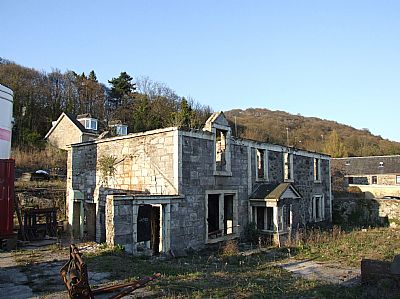
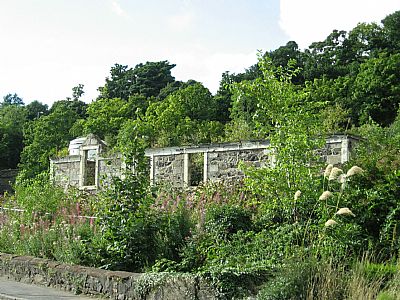
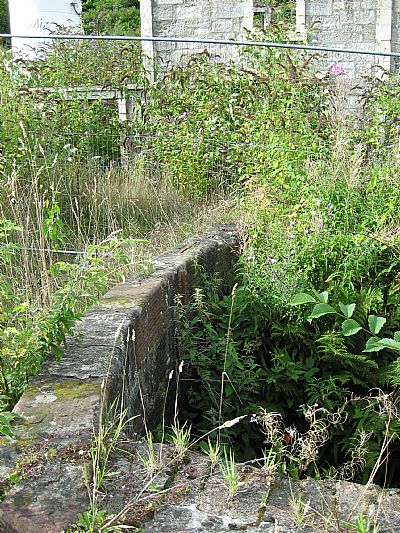
Here we see the edge of the water channel where it is between the road and the exciseman's house. You can see the edge wall in the picture above too.
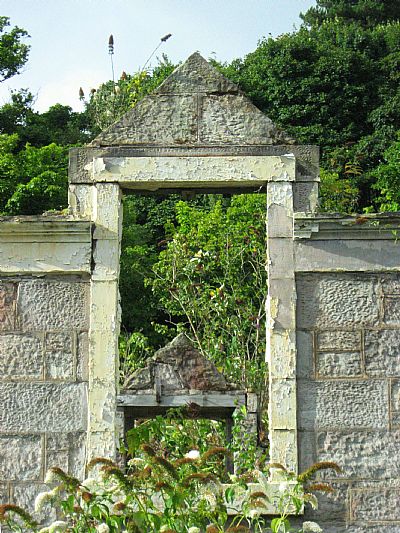
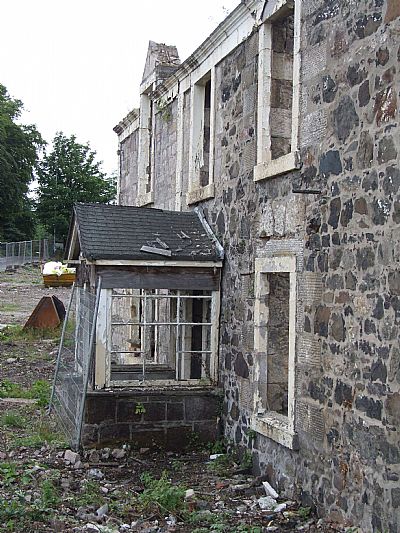
Over the years we have seen the house deteriorate until it is just a shell. Here is the front entrance when it still had window frames. Today the whole house is engulfed in vegetation such as the invasive and damaging buddleia.
But where is the distillery?
Well that was where the blocks of flats are now on both sides of the road.
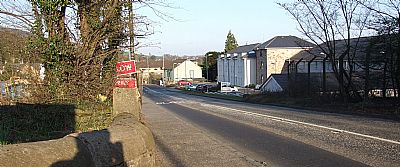
The exciseman's house was to the left behind that stone wall. The distillery was to the right where the flats now are. (There are now flats on both sides of the road).
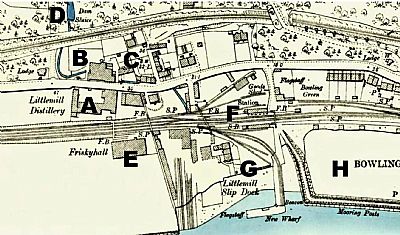
In this map of 1896 we see the distillery building at A. Across the road is what was further premises at B with the exciseman's house alongside it at C. Fresh water was channelled from the dam at D into those works and across in front of the exciseman's house. The station was at F and the Littlemill Slip Dock at G. East of that at H were the main docks. Two railway lines are shown. That furthest from the river is labelled as the Lanarkshire and Dumbartonshire Railway. It is this one that was removed and and transformed into a cycle track. The route curves across the other (remaining) line to become what is now the Bowline walking and cycle route above Bowling Basin. The other is much like it is today with the modern railway service although without the short branch sidings. NLS © as ref below.
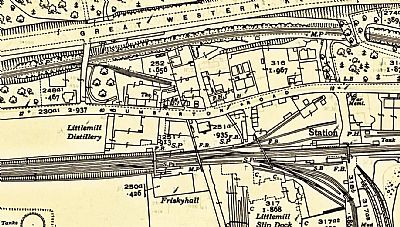
This map dates from 1937. Much remains the same, although you can now see that a branch siding has been provided off the Lanarkshire and Dumbartonshire Railway on the north side below the A82, here simply shown as Great Western Road. NLS © as ref below. While the branch sidings of the main line have gone, this is much as the railway now runs.
Canmore tells us that the distillery was founded in 1772. Between 1817 and 1971 the distillery had changed hands about 16 times. Littlemill used triple distillation until the 1930's and had two stills and a modified Saladin malting in 1980. [Canmore]. Some folk will remember the products with some sentimentality.
BUILDINGS AT RISK REGISTER FOR SCOTLAND (BARRS) : https://buildingsatrisk.org.uk/search/keyword/dumbarton/event_id/898807/building_name/littlemill-distillery-excisemans-house-dumbarton-road-bowling
CANMORE : https://canmore.org.uk/site/81823/bowling-dumbarton-road-littlemill-distillery-maltings-and-kilns This covers the distillery and includes a photographic record. & https://portal.historicenvironment.scot/apex/f?p=1505:300:::::VIEWTYPE,VIEWREF:designation,LB19656 This covers the house.
HISTORIC ENVIRONMENT SCOTLAND website for listed buildings : http://portal.historicenvironment.scot/designation/LB19656
LITTLEMILL DISTILLERY correspondence and website : https://www.littlemilldistillery.com/
NATIONAL LIBRARY OF SCOTLAND : MAPS :
1st map : Renfrewshire III.12 Revised: 1896, Published: 1897 https://maps.nls.uk/view/82900338
2nd map : Drawing for Dumbartonshire nXXII.8 Revised: 1937, Published: 1939, on a blue of previous edition https://maps.nls.uk/view/228781640
WEST DUNBARTONSHIRE HERITAGE TRAIL : OLD KILPATRICK, BOWLING AND MILTON, produced by the West Dunbartonshire Council as compiled by David Carson and David Harvie : https://www.west-dunbarton.gov.uk/heritagetrails

